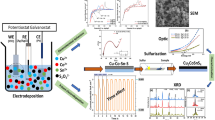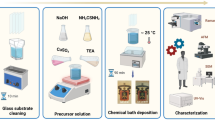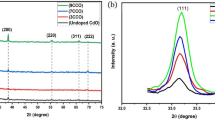Abstract
Tin-doped indium oxide In2O3 (indium-tin-oxide) transparent conducting films were fabricated on silicon substrates by a dip coating process. The thermal analysis of the ITO films was executed by temperature-programmed desorption (TPD) or thermal desorption spectroscopy (TDS) in high vacuum. Gas evolution from the ITO film mainly consisted of water vapor. The total amount of evolved water vapor increased on increasing the film thickness from approx. 25 to 250 nm and decreased by increasing the preparation temperature from 365 to 600°C and by annealing at the same temperature for extra 10 h. The evolution occurred via two steps; the peak temperatures for 250 nm thick films were approx. 100-120 and 205-215°C. The 25 nm thick films evolved water vapor at much higher temperatures; a shoulder at approx. 150-165°C and a peak at approx. 242°C were observed. The evolution temperatures increased by increasing the preparation and the annealing temperatures except in case of the second peak of the 25 nm thick films. The evolution of water vapor at high temperature was tentatively attributed to thermal decomposition of indium hydroxide, In(OH)3, formed on the surface of the nm-sized ITO particles.
Similar content being viewed by others
References
K. Mészáros-Szécsényi, J. Päiväsaari, M. Putkonen, L. Niinistö and G. Pokol, J. Therm. Anal. Cal., 69 (2002) 65.
M. Krunks, J. Madarász, T. Leskelä, A. Mere, L. Niinistö and G. Pokol, J. Therm. Anal. Cal., 72 (2002) 497.
Y. Sawada and N. Mizutani, Netsu Sokutei (Calorimetry and Thermal Analysis), 16 (1989) 185 (in Japanese).
Y. Sawada, K. Ohmika and Y. Ito, J. Thermal Anal., 40 (1993) 1145.
Y. Sawada and A. Hashimoto, Thermochim. Acta, 231 (1994) 307.
Y. Sawada and Y. Ito, Thermochim. Acta, 231 (1994) 47.
Y. Sawada and M. Suzuki, Thermochim. Acta, 232 (1994) 29.
Y. Sawada and M. Suzuki, Thermochim. Acta, 254 (1994) 261.
S. Seki, T. Aoyama, Y. Sawada, M. Ogawa, M. Sano, N. Miyabayashi, H. Yoshida, Y. Hoshi, M. Ide and A. Shida, J. Therm. Anal. Cal., 69 (2002) 1021.
S. Seki, Y. Sawada and T. Nishide, Thin Solid Films, 388 (2001) 22.
Y. Sawada, C. Kobayashi, S. Seki and H. Funakubo, Thin Solid Films, 409 (2002) 46.
S. Seki, T. Suzuki, T. Senda, T. Nishide and Y. Sawada, Thermochim. Acta, 352/353 (2000) 75.
N. Hirashita and T. Uchiyama, Bunseki Kagaku, 43 (1994) 757 (in Japanese). J. Therm. Anal. Cal., 77, 2004
Author information
Authors and Affiliations
Rights and permissions
About this article
Cite this article
Sawada, Y., Seki, S., Sano, M. et al. Evolution of water vapor from indium-tin-oxide transparent conducting films fabricated by dip coating process. Journal of Thermal Analysis and Calorimetry 77, 751–757 (2004). https://doi.org/10.1023/B:JTAN.0000041654.30854.2f
Issue Date:
DOI: https://doi.org/10.1023/B:JTAN.0000041654.30854.2f




